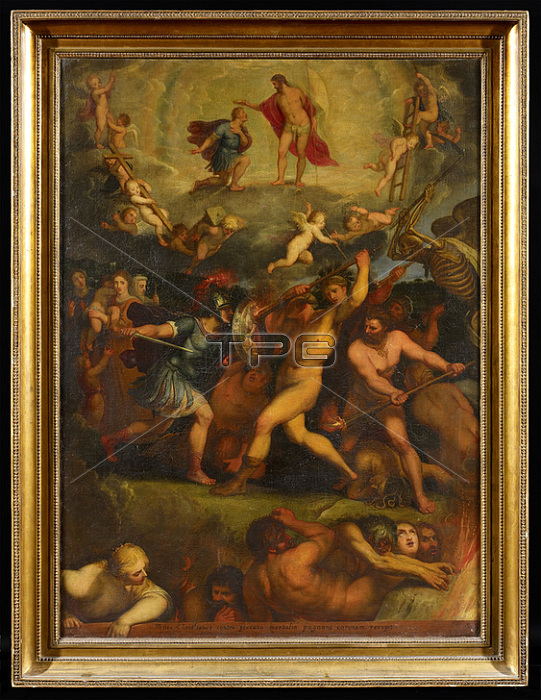
VEEN; OTTO VAN
1556 Leiden - 1629 Brussels
Miles Christianus. 1609-1629. Oil on canvas. 159 x 116cm. Inscription lower edge: Miles Christianus contra peccata mortalia pugnans coronam recipit. Framed.
Verso:
- Note on upper stretcher reading: 'Cabinet de tableaux J. Merlo'; inscription on canvas 'No. 8'; inscription on lower frame 'MC Witthoff a Cologne'.
Literature:
Ost; Hans; Unbekannte Werke von Otto van Veen; in: Wallraf-Richartz-Jahrbuch; Vol. LXVIII;
Cologne 2007; p. 279-294.
Provenance:
- Johann Jakob Merlo Collection; mid-19th century;
- 1890 sale at auction; unknown buyer;
- since 1920s private ownership; Cologne.
Otto van Veen; one of Antwerp's leading figure painters; was the teacher of Peter Paul Rubens. His work 'Miles Christianus'; impressively depicting the Christian knight's dramatic battle against the seven deadly sins and Death; was considered lost for ages. Hans Ost thoroughly appreciated the painting in his 2007 contribution 'Unbekannte Werke von Otto van Veen' to the Wallraf-Richartz yearbook.
The painting must have been created between 1609 and 1629 for a Cologne clergyman. During the 19th century it entered Johann Jakob Merlo's collection; who in 1850 made a name for himself in art history with his seminal writing 'Nachrichten vom Leben und den Werken K鰈nischer K黱stler' (News of the Life and Works of Cologne Artists). After his death in 1890; the painting was sold at auction and following years of uncertainty it was recently rediscovered in a private collection.
Merlos devoted a thorough accout to this work:
'As central part of my collection I cherish an allegorical painting by Otto Veenius; which displays; alongside exquisite technique; the artist's poetic spirit in its full grandeur. Intending to illustrate the subime truth that any true Christian had the inherent strength to overcome all temptations of evil and by that victory to gain the crown of eternal bliss. A young male; who in serene sublimity is guided by the virtues of faith; love; and hope; boldly and imperturbably wields his sword against the ferociously assailing vices; these are betrayed by their ingeniously selected attributes: gluttony; lust; wrath; envy; avarice; pride; and sloth - known as the seven cardinal sins. His shield bears the scene of Abraham sacrificing his son Isaac; a meaningful allusion to the imperative of obedience to God's commands. The fairest host of angels is floating above the young hero; presenting to him the Arma Christi as invigorating reminders; the ruptured ground however discloses an abyss; down which those who wandered from the straight and narrow are squirming in desperation; caught in the blaze; dammed to endure the agony of hell. (...) Aloft we gain a view of this glorious future of the Christan: within a halo embraced by the rainbow arch of peace; stands the Redeemer holding the victory banner with cross; rewarding the kneeling male with the crown of the Blessed. At the bottom stands be read: Miles Christianus contra peccata mortalia pugnans coronam recipit. (...) According to former owners; Otto Veenius painted this work; excellent in every respect; in Cologne for a noble art lover and member of the cathedral chapter - information that seems all the more plausible as the Italian school's style is predominant (initially reminding of Giulio Romano) and it seems to have been created shortly after his return from Italy; when he was still under the vivid imressions of his studies there.'
From the 4th century onwards the motif of the battle between vices and virtues has persisted in the arts. Its threefold composition is evocative of Doom paintings. The arrangement of allocating the 'good' to the left and the 'damned' to the right may also have been adapted from these medieval representations. This thought also goes in line with the fact that the fair principal female character at the bottom of the painting does not belong with the damned to her left; but is rather refering the viewer to the inscription below by leaning over the balustrade as to read it herself. According to Ost the wording testifies to Otto van Veen's 'intellectual literary; text-based interests'; hence to him being a pictor doctus. The motif itself can be traced to Paul's Epistle to the Ephesians in the Bible (Eph.6; 10-17). Otto van Veen worked at the court of Gerard von Groesbeck the Prince-pishop of Li間e; in Rome; at Emperor Rudolf II's court in Prague; and at the court of the House of Wittelbach in Munich; before eventually going to Cologne in 1583; where he was appointed court painter by Ernest of Bavaria the Prince-elector of Cologne. The time he spent in Italy probably inspired him to the painting at hand: it was adapted from a large Chiaroscuro woodcut by Andrea Andreani. Who; according to his own writings on the work; in turn referred to a drawing by Battista Franco; which is presumably lost today. Moreover; he adopted the monogram at the bottom of the image. While Merlo dated the painting to 1585; Ost gives convincing reasons to assume a later date of origin between 1609 and 1629.
The upper stretcher on the back of the painting bears a note reading 'Cabinet de tableaux J. Merlo'. The canvas is inscribed 'No. 8' and the lower frame reads 'MC Witthoff a Cologne'.
Art trade; Van Ham.
| px | px | dpi | = | cm | x | cm | = | MB |
Details
Creative#:
TOP28229830
Source:
達志影像
Authorization Type:
RM
Release Information:
須由TPG 完整授權
Model Release:
No
Property Release:
No
Right to Privacy:
No
Same folder images:

 Loading
Loading